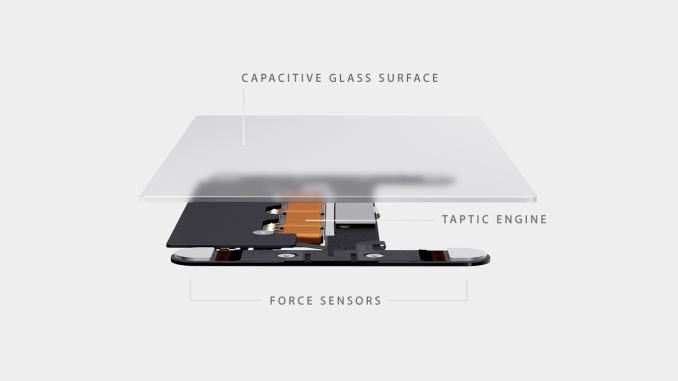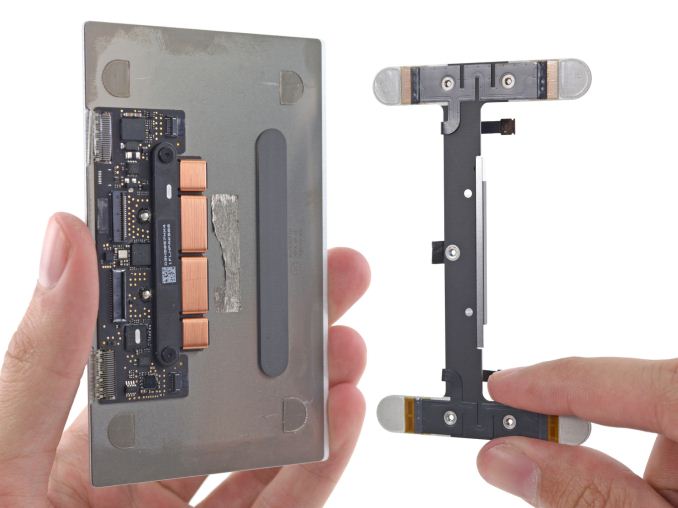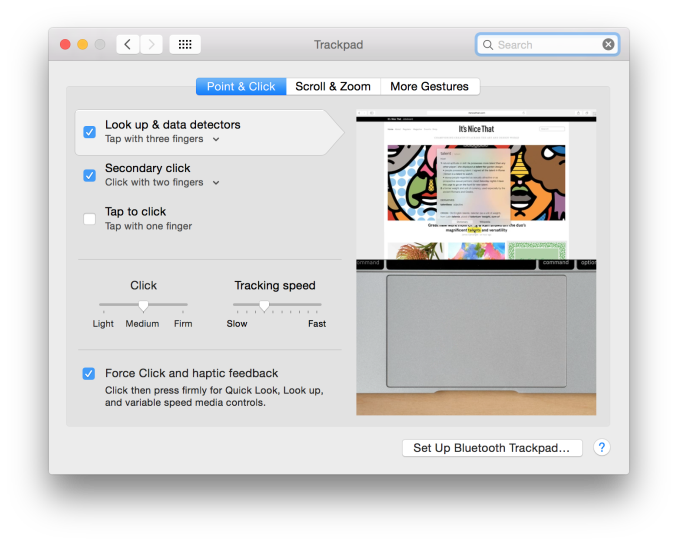The 2015 MacBook Review
by Ryan Smith on April 14, 2015 10:15 AM ESTForce Touch Trackpad
Along with Apple’s changes to their keyboard, the company has also gone in and significantly reworked their trackpad. The new Force Touch Trackpad represents the biggest change to Apple’s trackpad design since the creation of the capacitive, multi-touch pivoting trackpad introduced on the unibody MacBook Pro. In putting together the Force Touch Trackpad, Apple has significantly reworked the internals of the trackpad, creating a trackpad that behaves a lot like their traditional trackpad with some new features, but under the hood relies on some very different mechanisms.
The big change here is that Apple has done away with the traditional pivot and switch mechanism. With pivot and switch, the capacitive trackpad surface would act like a small touchscreen, and underneath it was a switch to register when the trackpad was pressed down. Mechanically the trackpad pivoted from the top (Apple likes to compare it to a diving board), with the trackpad inferring what action to take based on the combination of the capacitive readings and the switch reading. Multi-finger gestures would rely solely on the capacitive layer, primary/secondary clicks would be based on the number of fingers in use when the switch was actuated, etc.
The Force Touch Trackpad on the other hand eliminates the pivot and switch mechanism in favor of a combination of an electromagnet and force/pressure sensors. The pressure sensors essentially replace the physical switch, allowing the trackpad to tell when it has been pressed based on the amount of pressure, and thanks to the pressure sensors it can now tell how hard it has been pressed as opposed to the binary nature of the physical switch. Meanwhile without a physical switch in place to provide the clicking sensation and feedback of pressing down on the touchpad, Apple’s electromagnet – the Taptic Engine – activates to simulate the feeling and noise of pressing a switch.
Update 04/15/2015: iFixit has a great shot of the trackpad's internals, including a good look at just how big the electromagnet/taptic engine really is.
The end result is that the MacBook’s trackpad is among the first wave of devices that ships with Apple’s next generation trackpad and the enhanced capabilities that go with it. Ignoring the pressure sensitivity for a moment (we’ll get back to it), replacing the pivot and switch for an electromagnet works shockingly well. From a touch & feel standpoint the Force Touch Trackpad feels virtually identical to a traditional trackpad, to the point where it’s more than a bit uncanny. In practice you are not actually triggering a switch nor is the trackpad really moving (technically it’s deforming ever so slightly), but it sure feels like you’re working a switch. Apple has clearly done their homework on getting an electromagnet to emulate a switch, to great results. Meanwhile they don’t have the trackpad’s acoustics precisely matching a switch, but the resulting pinball-machine like plunk is close enough to a click that I don’t imagine anyone will mind the difference.
One side benefit of this change is that the trackpad feels the same throughout, and unlike the pivoting trackpad does not require more or less force depending on where you are relative to the pivot point. The variable force required has never been a major problem in my experience, but it is nice to no longer need to worry about where your fingers are relative to the top, and consequently how much force you need to use.
However the bigger deal is that by making the amount of force required to click consistent throughout the entire trackpad, Apple can now use the amount of pressure applied as another input, making the trackpad pressure-sensitive. The underlying pressure sensors and electromagnet are by default programmed to have two levels of feedback – a shallower press is equivalent to a click – and a deeper press brings about the pressure-sensitive “Force Click.” What force clicking does depends on the application, and right now it’s clear that Apple is still experimenting with what they can do with pressure sensitivity. The most obvious uses include line thickness in drawing applications, but the company is also using it for things such as variable speed fast forward and rewinding in QuickTime/iMovie. At times the force click is treated like a 3rd (tertiary) click, and other times the result is based on variable pressure. Since this is a new (and uncommon) feature there’s no global action assigned to the force click – nor does it behave as a middle click on a regular mouse – so what happens is up to the application.
In implementing force click and the Force Touch Trackpad, Apple does offer the ability to control the amount of pressure required and whether force click is active. With force click deactivated the trackpad behaves more or less identical to a traditional trackpad with a single click level. Meanwhile the click pressure setting is interesting, though I’m not entirely convinced it’s all that effective. Short of the tools to actually measure click pressure, I’m not so sure Apple is changing the amount of pressure required to trigger a click so much as they’re changing how hard the electromagnet vibrates. The feedback change is certainly very subtle going from light to firm, and if there is a change in the amount of pressure required then it is certainly equally subtle.
Ultimately whether the Force Touch Trackpad is a major upgrade or not is going to depend on a user’s ability to make use of the force click features. Even turned off, the new trackpad is essentially an improved version of the old trackpad without the minor drawbacks of the pivot mechanism. But with the force click turned on, then it brings new (though not always useful) actions to the trackpad that in turn makes it a bigger upgrade over the old trackpad.
In any case, the MacBook along with the 2015 MacBook Pro 13” are the first wave of devices to implement the new Force Touch Trackpad. Given its expanded capabilities I would expect Apple to eventually replace many (if not all) of their trackpads with this new design. Certainly the 15” MacBook Pro is a likely candidate, as is a future version of the Magic Trackpad. What remains to be seen is whether the next MacBook Air also gets this new trackpad, or if Apple withholds it to keep the products differentiated and to keep the costs of the MacBook Air down.














354 Comments
View All Comments
YuLeven - Wednesday, April 15, 2015 - link
He's talking about the rMBP 13. The MacBook isn't to be compared to the XPS 13, the rMBP 13 is. The machine reviewed here is a ultra-portable Core M laptop, why you bother comparing it to a standard fan equipped PC?pedromcm.pm - Tuesday, April 14, 2015 - link
A Dell is a Dell. No one is going to pay for a premium Dell computer, for various reasons.a) Windows;
b) It is in the price range of macbooks, that are proven to be better purchases.
In the real world, people aren't comparing the Dell Vs the Macbook. The Dell isn't even considered, and for good reason. For the same money you can get a mac that beats it on everything (rMBP 13"), or if you need more portability, you get a Macbook.
That despite slower processor than this Dell, has a better screen, trackpad, faster SSD and RAM, more efficient OS and as such will be a faster machine.
Also, the vast majority of people buying computers above 1000 $ are iPhone users. Another reason for them to not even consider Windows in this price range, since OS X is so superior as a part of the ecosystem.
pedromcm.pm - Tuesday, April 14, 2015 - link
p.s.: If it isn't for you, that's fine. It also isn't the right machine for me, but I can see how it is for must people.The Macbook will outsell the XPS 100 to 1. And it isn't because of marketing. It is because Apple earned the trust, Dell lost it, and the Macbook is just a better executed product.
TomPk - Thursday, May 14, 2015 - link
People will pay whatever they have to in order to get the best machine. If you think that the vast majority of people who pay over a grand for a computer don't even consider Windows, then you must not work with a lot of professionals.$1,300 is not a lot to pay for a computer in the long run, but the 13 inch MBP completely kills this new Macbook.
TEAMSWITCHER - Tuesday, April 14, 2015 - link
Interesting...You can't get an XPS 13 with a 512GB SDD. And even then it's only MSATA.Dorek - Tuesday, April 14, 2015 - link
As if the Core M in this is even fast enough for mSATA to be too slow.knolf - Wednesday, April 15, 2015 - link
You can. Here is how. You buy the basic 128 GB. By whatever M.2 SATA-3 512 GB SSD you like ( or larger ) . Take a screwdriver. Open the bottom. Remove the old SSD. Insert the new SSD.YuLeven - Wednesday, April 15, 2015 - link
The XPS 13 is heavier, larger, hotter and has a bloody fan. It's a great laptop, but comparing it to the MacBook is comparing oranges to apples. The one to be compared to the XPS 13 is the rMBP 13.knolf - Wednesday, April 15, 2015 - link
I'm comparing what I can get for 1299 $. For 1299 $ I can get a proper ultrabook with a real CPU.knolf - Wednesday, April 15, 2015 - link
Lets do the math. Dell XPS non-touch : 999 $ ( core I5, 128 GB SSD, 8 GB RAM ). Samsung P851 512 GB SSD : 250 $ ( Amazon ). M.2 SATA external USB 3.0 enclosure to give the standard 128 GB SSD a new home so I can reuse it as a fast USB 3.0 drive: 40 $. Total 1299 $. Same price as a Macbook. Only 250 gram 'heavier'. Yes that is a whopping 1/4 of a kg. Conclusion : the Macbook is maybe a 'great' ultrabook but it is way overpriced. Around the 1000 $ mark would be reasonable.